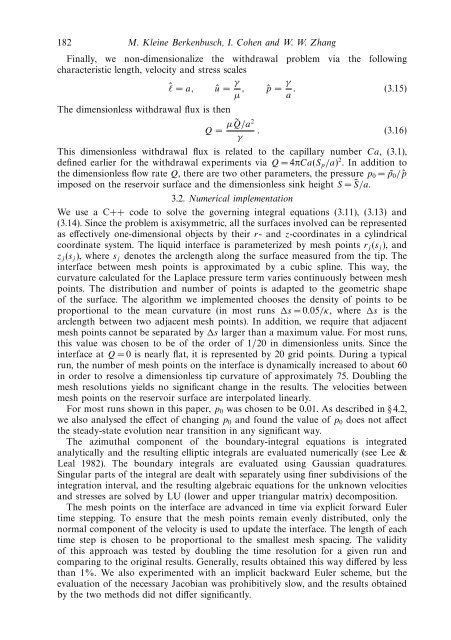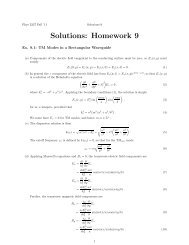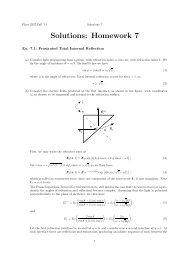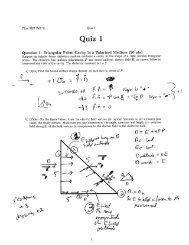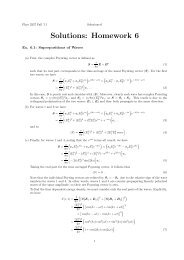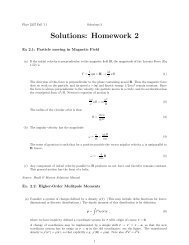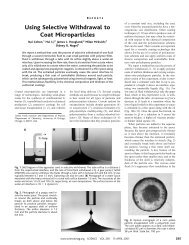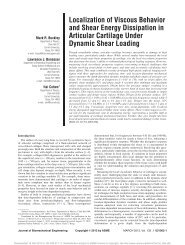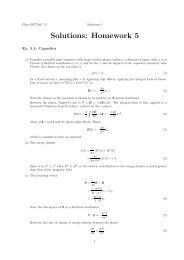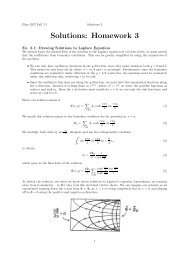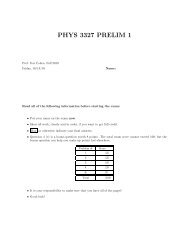Liquid interfaces in viscous straining flows ... - Itai Cohen Group
Liquid interfaces in viscous straining flows ... - Itai Cohen Group
Liquid interfaces in viscous straining flows ... - Itai Cohen Group
Create successful ePaper yourself
Turn your PDF publications into a flip-book with our unique Google optimized e-Paper software.
182 M. Kle<strong>in</strong>e Berkenbusch, I. <strong>Cohen</strong> and W. W. ZhangF<strong>in</strong>ally, we non-dimensionalize the withdrawal problem via the follow<strong>in</strong>gcharacteristic length, velocity and stress scalesˆl = a, û = γ μ , ˆp = γ a . (3.15)The dimensionless withdrawal flux is thenQ = μ ˜Q/a 2. (3.16)γThis dimensionless withdrawal flux is related to the capillary number Ca, (3.1),def<strong>in</strong>ed earlier for the withdrawal experiments via Q =4πCa(S p /a) 2 . In addition tothe dimensionless flow rate Q, there are two other parameters, the pressure p 0 = ˜p 0 / ˆpimposed on the reservoir surface and the dimensionless s<strong>in</strong>k height S = ˜S/a.3.2. Numerical implementationWe use a C++ code to solve the govern<strong>in</strong>g <strong>in</strong>tegral equations (3.11), (3.13) and(3.14). S<strong>in</strong>ce the problem is axisymmetric, all the surfaces <strong>in</strong>volved can be representedas effectively one-dimensional objects by their r- andz-coord<strong>in</strong>ates <strong>in</strong> a cyl<strong>in</strong>dricalcoord<strong>in</strong>ate system. The liquid <strong>in</strong>terface is parameterized by mesh po<strong>in</strong>ts r j (s j ), andz j (s j ), where s j denotes the arclength along the surface measured from the tip. The<strong>in</strong>terface between mesh po<strong>in</strong>ts is approximated by a cubic spl<strong>in</strong>e. This way, thecurvature calculated for the Laplace pressure term varies cont<strong>in</strong>uously between meshpo<strong>in</strong>ts. The distribution and number of po<strong>in</strong>ts is adapted to the geometric shapeof the surface. The algorithm we implemented chooses the density of po<strong>in</strong>ts to beproportional to the mean curvature (<strong>in</strong> most runs s =0.05/κ, where s is thearclength between two adjacent mesh po<strong>in</strong>ts). In addition, we require that adjacentmesh po<strong>in</strong>ts cannot be separated by s larger than a maximum value. For most runs,this value was chosen to be of the order of 1/20 <strong>in</strong> dimensionless units. S<strong>in</strong>ce the<strong>in</strong>terface at Q = 0 is nearly flat, it is represented by 20 grid po<strong>in</strong>ts. Dur<strong>in</strong>g a typicalrun, the number of mesh po<strong>in</strong>ts on the <strong>in</strong>terface is dynamically <strong>in</strong>creased to about 60<strong>in</strong> order to resolve a dimensionless tip curvature of approximately 75. Doubl<strong>in</strong>g themesh resolutions yields no significant change <strong>in</strong> the results. The velocities betweenmesh po<strong>in</strong>ts on the reservoir surface are <strong>in</strong>terpolated l<strong>in</strong>early.For most runs shown <strong>in</strong> this paper, p 0 was chosen to be 0.01. As described <strong>in</strong> § 4.2,we also analysed the effect of chang<strong>in</strong>g p 0 and found the value of p 0 does not affectthe steady-state evolution near transition <strong>in</strong> any significant way.The azimuthal component of the boundary-<strong>in</strong>tegral equations is <strong>in</strong>tegratedanalytically and the result<strong>in</strong>g elliptic <strong>in</strong>tegrals are evaluated numerically (see Lee &Leal 1982). The boundary <strong>in</strong>tegrals are evaluated us<strong>in</strong>g Gaussian quadratures.S<strong>in</strong>gular parts of the <strong>in</strong>tegral are dealt with separately us<strong>in</strong>g f<strong>in</strong>er subdivisions of the<strong>in</strong>tegration <strong>in</strong>terval, and the result<strong>in</strong>g algebraic equations for the unknown velocitiesand stresses are solved by LU (lower and upper triangular matrix) decomposition.The mesh po<strong>in</strong>ts on the <strong>in</strong>terface are advanced <strong>in</strong> time via explicit forward Eulertime stepp<strong>in</strong>g. To ensure that the mesh po<strong>in</strong>ts rema<strong>in</strong> evenly distributed, only thenormal component of the velocity is used to update the <strong>in</strong>terface. The length of eachtime step is chosen to be proportional to the smallest mesh spac<strong>in</strong>g. The validityof this approach was tested by doubl<strong>in</strong>g the time resolution for a given run andcompar<strong>in</strong>g to the orig<strong>in</strong>al results. Generally, results obta<strong>in</strong>ed this way differed by lessthan 1%. We also experimented with an implicit backward Euler scheme, but theevaluation of the necessary Jacobian was prohibitively slow, and the results obta<strong>in</strong>edby the two methods did not differ significantly.


